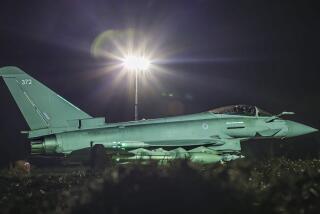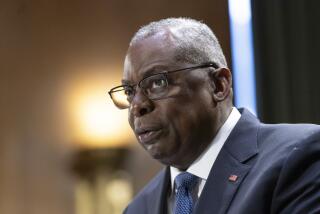Raid Targeted a Residence of Taliban Leader
WASHINGTON — An early-morning assault Saturday by American ground forces in southern Afghanistan targeted the home of the ruling Taliban’s leader as well as a military airfield, U.S. officials said, characterizing it as the first of many raids designed to decimate terrorist networks.
More than 100 Army Rangers and other U.S. commandos participating in the operation parachuted into a Taliban leadership complex near the southern Afghan city of Kandahar and an airfield some distance away, said Gen. Richard B. Myers, chairman of the Joint Chiefs of Staff.
Officials suggested that the raids were not the only missions conducted and that covert operations against undisclosed targets also took place. Small special operations teams from the United States and Britain have been conducting surveillance and intelligence work in Afghanistan for weeks, officials said. But Saturday’s operations were the first commando raids in the campaign, they said.
Gen. Abdul Rashid Dostum, an Uzbek warlord in northern Afghanistan, confirmed last week that at least eight U.S. soldiers have been with his troops as they fight to seize the strategic northern city of Mazar-i-Sharif.
But the Americans have been discussing food aid for the drought-stricken area, Dostum told reporters from his base in Dara-i-Suf, about 55 miles southeast of Mazar-i-Sharif.
U.S. bombing of the Central Asian nation continued at a fierce pace after Saturday’s raid, defense officials said. The sorties involved more than 100 Navy strike aircraft, several Air Force bombers and a few Air Force fighter-bombers.
In Shanghai, at a meeting of Pacific Rim leaders, President Bush said the military campaign is “encircling” the militants of Osama bin Laden’s Al Qaeda terrorist network and making good progress in destroying their hide-outs. He also asserted that the defenses of the Taliban are being dismantled.
Bush warned, however, that the war on terrorism will include “moments of sacrifice.”
The complex targeted in Saturday’s raid is one of several residences used by Mullah Mohammed Omar, leader of the Islamic fundamentalist regime. Although Omar and other Taliban officials were not there when U.S. forces arrived, the mission was considered a success, Myers said.
A senior Taliban leader, Amir Khan Muttaqi, told the pan-Arab TV network Al Jazeera that the regime’s fighters had driven off the Americans and that “this commando attack has failed.”
Saturday’s operations produced the first U.S. combat fatalities since the military operation began Oct. 7. Two soldiers died, and three were injured, when a U.S. Black Hawk helicopter preparing for search-and-rescue duty crashed near its base in neighboring Pakistan, Myers said. Reports from the area said the crash occurred 15 miles across the border near the Pakistani nuclear test site at Chagai, about 30 miles north of a civil aviation airport at Dalbandin. A limited number of American troops is based at Dalbandin. In addition, three U.S. commandos involved in the raids suffered minor injuries as they parachuted to the ground.
Defense officials are still investigating the cause of the helicopter crash, but Myers said the Black Hawk was not shot down and did not collide with another aircraft or vehicle.
Commandos Gathered Intelligence From Site
The commandos destroyed a cache of weapons at the Taliban leadership site, including rocket-propelled grenade launchers and machine guns, defense officials said, and gathered what the officials believe is critical intelligence. About the same time, other Special Forces members swooped down on a Taliban airfield “a considerable distance” southwest of Kandahar, one defense official said.
American troops battled Taliban fighters at both sites, inflicting an undetermined number of casualties on the Afghan forces, U.S. officials said.
Defense officials said the Special Forces were hustled out of the area within a few hours, but not before leaving behind what might be characterized as combat calling cards: photographs of firefighters planting an American flag in the rubble of the World Trade Center and draping a flag over the wrecked side of the Pentagon. Printed on the photos were the words “Freedom Endures.”
The identities of the two soldiers killed in the helicopter crash were being withheld Saturday until relatives were notified. Myers said heavy dust clouds created by the chopper’s blades during landing probably led to the crash.
Myers would not say precisely where the helicopter was based. About 250 Marines are stationed at a Pakistani base in Jacobabad, about 300 miles southeast of Kandahar, for search-and-rescue missions.
Despite the deaths of the soldiers, Myers said the mission was considered a success because the commandos “attacked and destroyed targets associated with terrorist activity and Taliban command and control.”
Myers said an undetermined number of Taliban forces was killed or injured. He would not say whether U.S. forces took any prisoners.
No reporters were present to observe the raids. The Pentagon contends that media coverage could undermine such missions.
Video clips taken by military personnel and shown to reporters Saturday depicted Rangers outfitting themselves for the mission in the desert-hued camouflage, strapping on packs loaded with more than 100 pounds of weapons and other gear, and parachuting onto the airfield. It was not possible to discern any details of the operation from the footage.
Myers said some details will be kept secret because they could help the Taliban anticipate how future ground attacks will be carried out.
Officials said the Rangers parachuted onto the airfield from an MC-130E Combat Talon, a special operations aircraft designed to fly nighttime troop delivery missions at low altitudes below enemy radar. It was not clear how the Rangers got to their second target, the residence and command compound closer to Kandahar. Myers said various aircraft were used in the mission, but he would not be specific.
Other Residences of Leader Had Been Hit
U.S. warplanes had already struck other residences of Omar during two weeks of bombing, but Myers said the target of Saturday’s raid had not been attacked before. He said U.S. officials were not surprised that the Taliban leader wasn’t there.
Military officials said the operation began a few hours after the Muslim holy day came to a close. It was preceded by a day of intense bombing that pounded 18 targets, including airfields, air defense facilities, ammunition depots and military training sites. At one target, defense officials believe, their laser-guided bombs destroyed a number of Taliban surface-to-surface missiles.
Myers refused to say whether U.S. forces remained in control of the airfield after Saturday’s raid or whether the troops who carried out the raids were still in Afghanistan.
“They are now refitting and relocating for potential future operations against terrorist targets and other areas known to harbor terrorists,” he said.
*
Times staff writers Robin Wright and Edwin Chen in Shanghai, Rone Tempest and Tyler Marshall in Islamabad, Pakistan, and Paul Watson in Wollayet, Afghanistan, contributed to this report.
More to Read
Sign up for Essential California
The most important California stories and recommendations in your inbox every morning.
You may occasionally receive promotional content from the Los Angeles Times.









